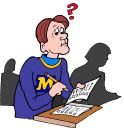| Date | Topic |
| Review of and Crash Course in General Topology |
| Aug 28 | Topological Vocabulary:
Ch. I, Sections 2-3 |
| Aug 30 | Mostly connectedness:
Ch. I, Section 4; plus definition of Hausdorff: Ch. I, Section 5 |
| Sep 1 | Compactness, proper mappings, product topology: Ch. I, Sections 7-8 |
| Sep 6 | Quotient topology: Ch. I, Section 13 |
| Sep 8 | Homotopy: Ch. I, Section 14 |
| Sep 11 | More Homotopy: Ch. I, Section 14 |
| A brief tour of differentiable manifolds:
This material provides motivation and examples for what we will be studying.
For those interested, an undergraduate level treatment can be found in Guillemin and Pollack, Differential Topology, which is inspired by the well-known introduction by Milnor, Topology from the Differentiable Viewpoint. |
| Sep 13 | Definitions of (smooth) manifold and examples: Ch. II, Sections 2-4 |
| Sep 15 | Poincare Conjecture, Exotic Spheres, the graph of the absolute value function in
R2 as a manifold (Exercise II.2.4: compare with the discussion of the cone
following Definition II.4.5), manifold with boundary (Definition II.2.7),
brief discussion without proof of classification of one and two dimensional
compact connected manifolds, allowing boundary in the 1-dimensional case,
tangent vectors & differentials (Ch. II, Sec. 5),
Tangent Bundles (Ch. II, Sec. 9), and the Whitney Embedding Theorem
without proof (Ch. II, Sec. 10) |
| Homotopy & Fundamental Group |
| Sep 18 & 20 | Definition of fundamental group and
the computation of the fundamental group for
R2\{(0,0)} using "net change in argument" (or winding
numbers). This is a variation on Ch. III, Sec. 1-2. |
| Sep 22 | Spheres are simply connected (Th. III.2.2) and
fundamental group of a product space (Th. III.2.6) |
| Sep 25 | Covering Spaces: Ch. III, Sec. 3 |
| Sep 27 | The Lifting Theorem: Ch. III, Secs. 4
& 5 |
| Sep 29 | Deck Transformations: Ch. III, Sec. 6 |
| Oct 2 | Seifert-Van Kampen: Ch. III, Sec. 9 |
| Oct 4 | Properly discontinuous actions (Ch. III,
Sec. 7), Lens Spaces, Classification & existence of coverings
(Ch. III, Sec. 8),
SO(3,R) (Ch. III, Sec. 10) |
| Oct 6 | TEST: The test will emphasize
definitions, vocabulary, statements of theorems, and "easy" consequences,
for example calculating the fundamental group of RP2.
It will cover
Ch. I, Sec. 14 (homotopy), and Ch. III, Secs. 1-6
(fundamental group & covering spaces).
Click here for the test solutions. |
| Singular Homology |
| Oct 9 | Singular simplices & definition of homology:
Ch. IV, Sec. 1 |
| Oct 11 | Augmentation map, zero homology group, and reduced
homology: Ch. IV, Sec. 2 |
| Oct 13 | H1 is isomorphic to the Abelianized
fundamental group: Ch. IV, Sec. 3 |
| Oct 16 | A less than successful introduction to homological
algebra and diagram chasing: Ch. IV, Sec. 4 |
| Oct 18 | A more successful day diagram chasing:
Ch. IV, Sec. 4 |
| Oct 20 | Eilenberg-Steenrod-Milnor Axioms: Ch. IV,
Sec. 6 |
| Oct 23 | Homology of Spheres & Brower Fixed Point
Theorem: Ch. IV,
Sec. 6 |
| Oct 25 | Degree of the antipodal map & consequences
for even dimensional spheres: Ch. IV, Sec. 6
|
| Oct 27 | Local Homology Hi(X,X\{x}); Invariance of dimension (see the discussion following Corollary IV.19.10); Homology of RP2: Ch. IV, Sec. 7 |
| Oct 30 | CW Complexes (definition) and examples:
Ch. IV, Sec. 8 |
| Nov 1 | Start toward cellular homology: Lemma IV.10.1 |
| Nov 3 | TEST: Chapter IV, Sections 1-6 (up
to and including 6.14), plus Section 8.
Click here for the test solutions. |
| Nov 6 | Cellular homology: page 202 and a sketch
of Theorem 10.3. Homology of real projective space: Ch. IV,
Sec. 14 |
| Nov 8 | Chain homotopy and singular homology of
contractible spaces: Ch. IV, Sec. 15 |
| Nov 10 | Cross product and the proof that singular homology
satisfies the homotopy axiom: Ch. IV, Sec. 16 |
| Nov 13 | Subdivision, Excision, and Mayer-Vietoris:
Ch. IV, Sec. 17-18 |
| Nov 15 | Embeddings of disks and spheres into spheres:
Ch. IV, Sec 19; consequences of the Borsuk-Ulam Theorem:
Ch. IV, Sec 20 |
| Nov 17 | Borsuk-Ulam Theorem: Ch. IV, Sec 20 |
| Cohomology |
| Nov 20 | Differential forms & de Rham cohomology:
Ch. V |
| Nov 22 | Differential forms & de Rham cohomology:
Ch. V |
| Nov 27 | de Rham's Theorem: Ch. V, Sec. 9 |
| Nov 29 | Universal Coefficient Theorem:
Ch. V, Sec. 7 |
| Dec 1 | TEST:
Know the definitions of the following concepts and statements of the
following theorems: The cross product theorem (Th. IV.16.1),
Mayer-Vietoris (Th. IV.18.1), Generalized
Jordan Curve Theorem (Th. IV.19.4), Invariance of Domain
(Cor. IV.19.9), Borsuk-Ulam Theorem and its consequences (Ch. IV,
Sec. 20), differential form, exterior derivative, de Rham cohomology,
singular cohomology, de Rham's Theorem (Th. V.9.1) |
| Dec 5 | Cross, Kroneker, cup, and cap products. Kunneth formula.
Ch. VI |
| Dec 7 | Compactly supported de Rham cohomology, Poincare duality
from the de Rham perspective, intersection theory |
| Dec 11 | FINAL (open book):
Expect exercises from the following sections of the book:
I.14, III.2-6, III.9, IV.4, IV.10, IV.18, IV.20. Expect some of these
problems verbatim and some using similar techniques. |

